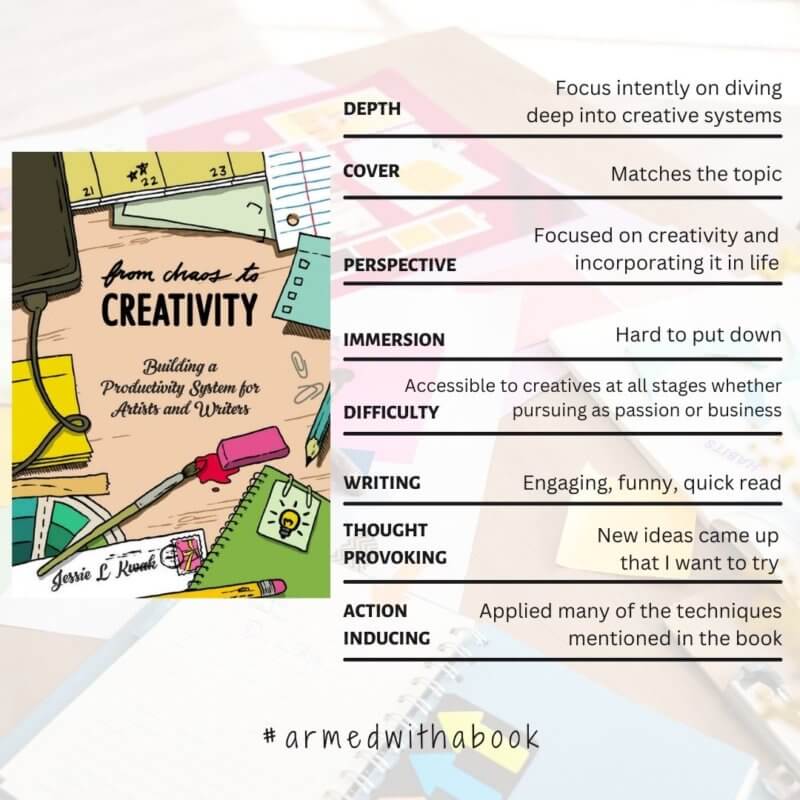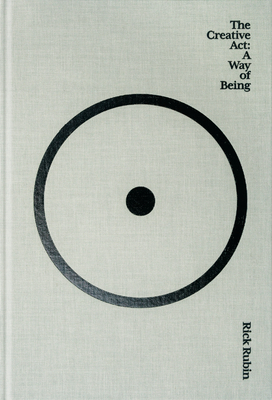From Chaos to Creativity by Jessie L. Kwak is a book that joined my TBR in 2020. I loved the concept of this book then, creating a creative system. I even started it but the problem was that in early 2020, I was still in the exploring phases. I was blogging and staging on Instagram but I didn’t know what I was creative in and why I even needed a system to keep going.
Three years later, I have a solid system that has primarily evolved in the last year. While reviewing this wonderful book, I am going to share more about my personal system of managing all my creative pursuits. If you are curious, keep reading. 🙂

From Chaos to Creativity
By Jessie L. Kwak | Goodreads
Art and writing can be the most fulfilling part of our lives. But it’s often difficult to make space for it in our day-to-day existence, especially if we’re not at the point yet where creating it is our job. Sometimes we have so many ideas it’s difficult to keep them all organized, much less maintaining a creative schedule or dedicated workspace. With all the clutter overwhelming your scattered brain (not to mention your desk), it’s all too easy to fall into procrastination and disarray. From Chaos to Creativity is a series of glowing beacon. Jessie L. Kwak has written a Getting Things Done for artists and writers, drawing on her experience as a professional copywriter with a novel-writing habit, and from interviews with other authors, artists, musicians, and designers, to teach you how to focus on the good ideas, manage your project, make time in your life, and execute your passions to completion. Make great art by channeling your chaotic creative force into productive power and let the world see what you’re capable of!
Thoughts on From Chaos to Creativity
The Four Parts
From Chaos to Creativity is a short and impactful read divided into four parts: Planning, Working, Dreaming and Testing.
- Planning is all about gathering the ideas and bringing everything in one place. We don’t want to miss out on the ideas we have or worry we will forget them before we get to them. I used to feel this way and writing it down somewhere helped a lot. But that is only the first step. The chaos has to be tamed so that the work can begin.
- Working is using planning optimally so that when we have the time to be creative, we utilise it optimally. This one is also about making routines and finding the times when we are at our best to work.
- Dreaming is super important as it lets our brain rest and come up with even more ideas to add to our planning. This is all about pursuing things that give us joy.
- Testing is all about reflecting on the systems we have built and tweaking them as we try them or as our priorities and time evolve.
Jessie gives lots of tools to the reader. She shares which apps she uses for these different stages and how she has incorporated them in her everyday/weekly routine. There are also exercises at the end of each part so that readers can apply what they learned, take a moment and think about where they are right now in their creative system and how the new concepts they have learned can take the system to the next level.
Having built a system for myself, these are exactly the stages that I have gone through. I just didn’t know until Jessie named them and walked me through them. What a great teacher!
Gathering & Organizing the Chaos
When you have an idea, what do you do with it? Maybe you text it to yourself, maybe you write in your journal. What if you don’t have your journal handy?
I loved Jessie’s idea of spending some time every week gathering all the loose ends to sort out. I was doing something similar but I didn’t see it until I read Jessie’s system. From Chaos to Creativity gave me the push to dedicate some time to look through everything and put it where it belongs.
Using language from Your Writing Matters, my Top Thing is writing. I write non-fiction about fiction and non-fiction. I love reading, and writing is the reason I read more. I decide which books I am reading in a month in advance. I take a long time curating this list. Sometimes, I have to see a book’s name pop up constantly in my reading list from 2 months from now to finally be able to read it. My TBR is approaching 400 books and I add a couple more a week to it. I know I will never read them all but a system lets me give them a fair shot and by reading, I get to write about them, sometimes pages and pages (my reviews can be as many as 1500 words). This then enables other aspects of my creativity – staging for instagram, creating graphics, collaborating with authors.
Side Note:
I have asked many book bloggers this question: what advice would you give someone just starting out in book blogging? The answers are generally the same – to know what you are writing about or to know your reading tastes.
Book blogging is not just about reading. Writing is not an easy endeavour. If you don’t like writing, you cannot be a book blogger. You won’t want to come back to it. There is no one template for writing reviews so find how you want to write them first. In today’s world where social media is such a huge part of our lives, we can sometimes forget that it’s not about putting content out there, it is about making the content we love.
In Year 29, I made a promise to myself to write about every single book that I read. It wasn’t tied to the blog. This relates to Jessie’s recommendation of having a spot for all the chaos. I have a go-to place for writing my reviews. I have done many iterations (testing) to arrive at this system. Before, I used to write directly in the blog editor, then I moved to having a separate document for each review. Finally, I have moved to one space. It is clean and focused on writing. It’s just about writing. It’s easy. It does not have an additional task of creating a new document every time – the dreaded blank page – or a million reminders to set keywords for the web page, fill out SEO details, add features images and so on. I am 376 pages into this document which houses over 80 reviews. It is breathtaking and I love coming back to it.
So my advice: Do it for yourself first. In that process, you will find your passion and your system.
Choosing Priorities
My biggest takeaway in this phase was to focus on the action rather than the results. It’s a concept that has been iterated in many many books, most recently in How to Keep house While Drowning (Goodreads, review) – it is ok to start folding the laundry, even if I don’t end up finishing it. Making some progress by taking action is better than not doing anything. Who knows, maybe just taking the action might motivate us to complete the task? There is no right and wrong way of doing things. As KC explores in her book, tasks are neutral, we are the ones who judge ourselves for them.
I loved Jessie’s recommendation to have a No list. I am sure there are things you already know you would never work on anyway so why spend time asking yourself if you want to this time?
Dream
More and more I see non-fiction books talk about taking the time to relax and play. Pursue something we love. For those who need the word, it is productive to explore and play, whether you enjoy video games or art. In my upbringing in particular, studying was the main thing. Art, reading, games were never seen as something productive. But I needed breaks from studying and homework to pursue my hobbies. This helped recollect my energy for the must-do stuff. Through hobbies, I experience joy. Maybe it is an idea we have to change in our minds. As adults, we can call anything we want productive. It is about what it makes us feel, not what society deems as worthy.

If you want regular creativity in your life, this is the book for you! It’s not just for the people who made it into a full time job. No matter how much time you are able to dedicate to creativity, the actual doing, the reason you need a system is to cut out the crap – the indecision, the lack of inspiration, the what-do-I-do-next. When I started collecting my ideas in one place, I started to spend more time doing. It has been amazing. If you have been reading my monthly wrap ups, you have probably noticed the writing stats. I will pop them for you in a chart here:

When I am in the mood to write, I always have a list of books handy that are pending reviews. When I am planning out the blog schedule for the week/month, I have a list of books I have reviews all written out for and I can choose from amongst them to post! It makes the decision making so easy and I can move into doing. 🙂
While August is going to require some writing time before I forget all about the 4 fantasic books that I need to tell you about, Tomorrow, and Tomorrow, and Tomorrow, The Creative Act, The African Samurai, and Wuthering Heights, when the writer in me calls or is called to the laptop, there are so many books to dive into again.
Additional Reading
There are a number of books that have informed by the journey of a creative system.

(Most recently) The Creative Act by Rick Rubin | Goodreads | Insta Review
They have all been influences in unique ways and I look forward to sharing their contributions in another post.
In many ways, From Chaos to Creativity was parallel to Make Time: How to Focus on What Matters Every Day by Jake Knapp and John Zeratsky. Both emphasise the need to prioritize, take action (no matter how small it is), energise and reflect.
While Jessie’s book is succinct and targeted for a creative audience, Jake and JZ focus on life in general. They have numerous ideas for how to limit distractions and make progress on the priorities we have identified. I recommend checking out their book. You can read my review here. The book is also on Goodreads.
Thank you so much for making it to the end of this post! Add From Chaos to Creativity to your TBR. Here is the Goodreads link. It is a short book that you will fly through in no time and get so much out of, I promise.
Stay tuned for the interview with Jessie tomorrow. 🙂




Be First to Comment